Spring is the season of new beginnings and new growth. As the temperature starts to warm up and everything begins to thaw from the winter, spring foraging options increase! This is the time of year for fresh salad greens, tasty spring flowers and shoots, medicinal plants, and a few edible mushrooms. This list of what to forage in spring will help you get started on your spring foraging adventure!
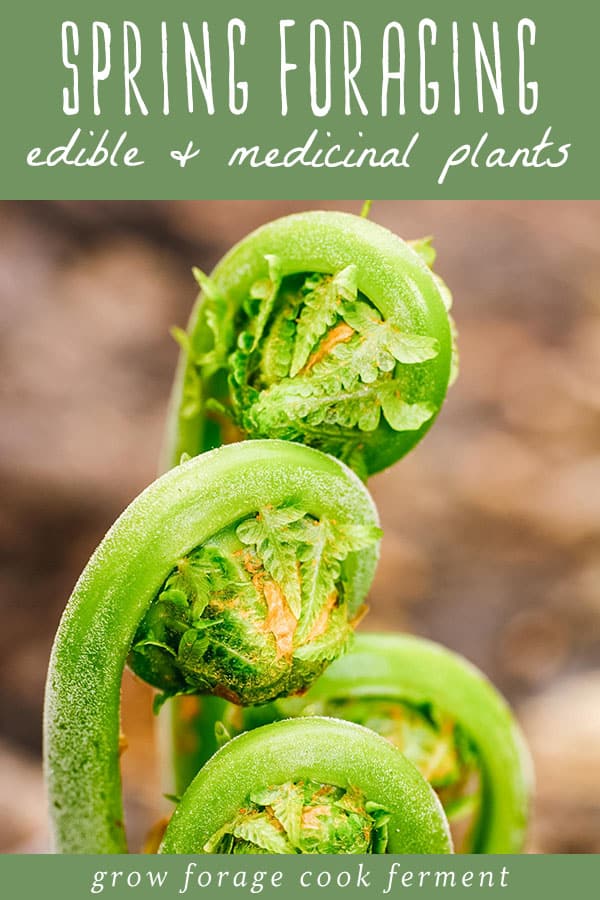
Want to save this post for later?
Wildcrafting Weeds
If you want to learn more about the edible and medicinal weeds that surround us and how to use them, check out my eBook: Wildcrafting Weeds: 20 Easy to Forage Edible and Medicinal Plants (that might be growing in your backyard)!
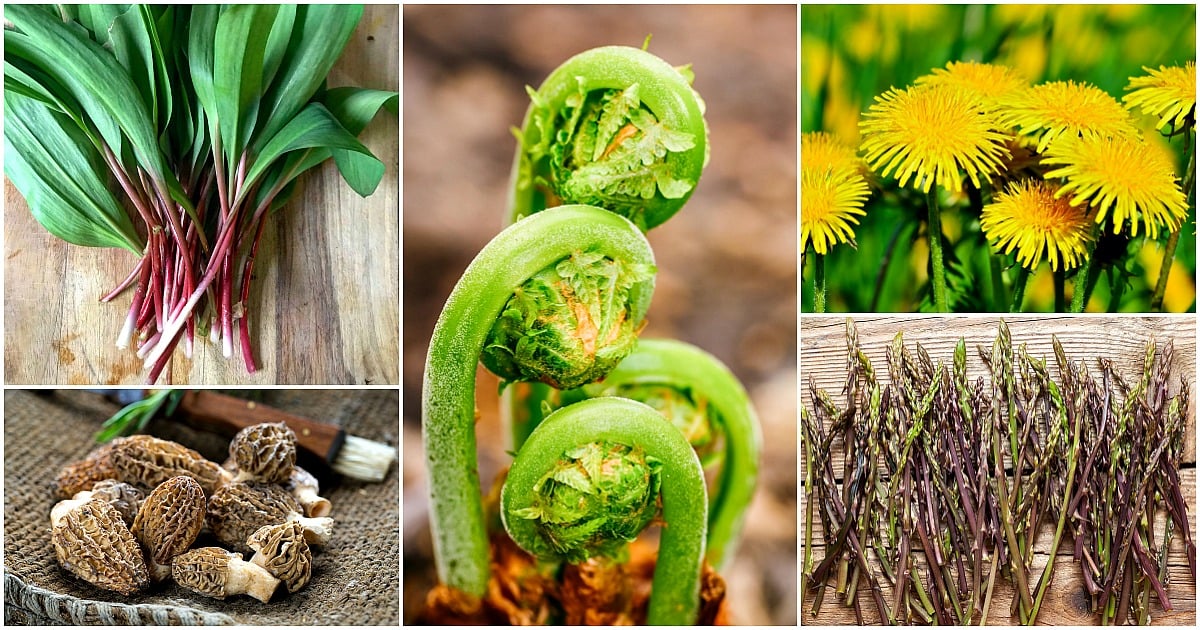
20 Edible and Medicinal Plants and Fungi to Forage in Spring
Before you begin foraging or wildcrafting, it’s really important to get a guidebook to use as a reference. You can find my favorite foraging guidebooks here and also some of the best foraging books for kids here.
Dandelion
Dandelions (Taraxacum officinale) are the quintessential spring foraging plant, with edible and medicinal flowers, leaves, and roots! They are super easy to identify, and any look-a-likes are edible and medicinal as well, so no worries there.
Dandelions are one of my favorite edible and medicinal weeds to forage and is one of the easiest backyard weeds to identify during spring. Make dandelion salve with the flowers, dandelion pesto with the leaves, and dandelion root coffee with the roots.
If you’re worried about harvesting dandelion blossoms in the spring because they might be food for bees, it’s actually not as big of a problem as it’s been made out to be.
Dandelions are actually not the best food for bees, and there are many other flowers we should be saving and planting for bees instead! (Read this post on flowers to plant for the bees).
Read more about foraging for dandelions and foraging for dandelion root here.
Related: 50 Ways to Use Dandelions and 13 Early Spring Edible Wild Greens
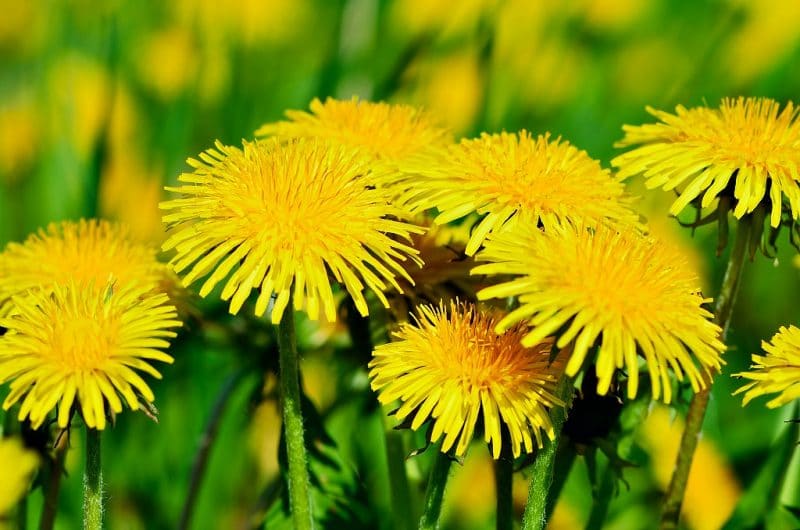
Chickweed
Chickweed (Stellaria media) is a tasty edible green that comes up in early spring. In some milder locations, it will even grow throughout winter.
Once it warms up chickweed will die back, so be sure to get it while you can so that you can add it to salads, make chickweed pesto, or even, chickweed salve!
Read more about foraging for chickweed here.
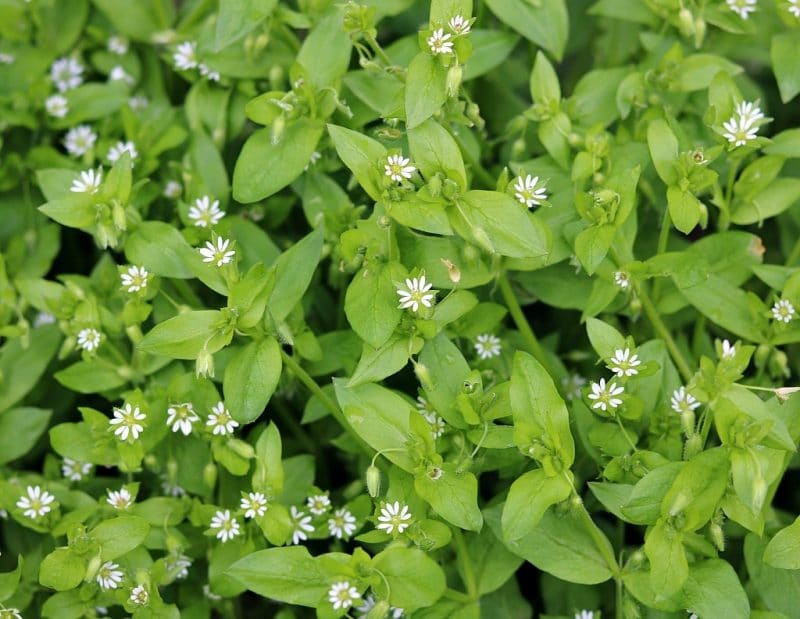
Miner’s Lettuce
Miner’s Lettuce (Claytonia perfoliata) looks a little bit like chickweed and is sometimes confused with it, but it is a different plant. It is a delicious salad green that grows wild in western states but can be cultivated in other areas.
Like chickweed, it prefers cooler temperatures and will sometimes grow right through the winter.
Read more about foraging for miner’s lettuce here.

Wild Violet
Wild violets (Viola sororia or Viola odorata) and their leaves are both edible and medicinal. They come up in early spring and are often the first flowers of the season, making them a lovely sight!
They love cooler temperatures and will grow through the winter in warmer locations.
Make violet flower infused vinegar, wild violet soap, or violet leaf balm with your foraged violets!
Read more about foraging for wild violets here.
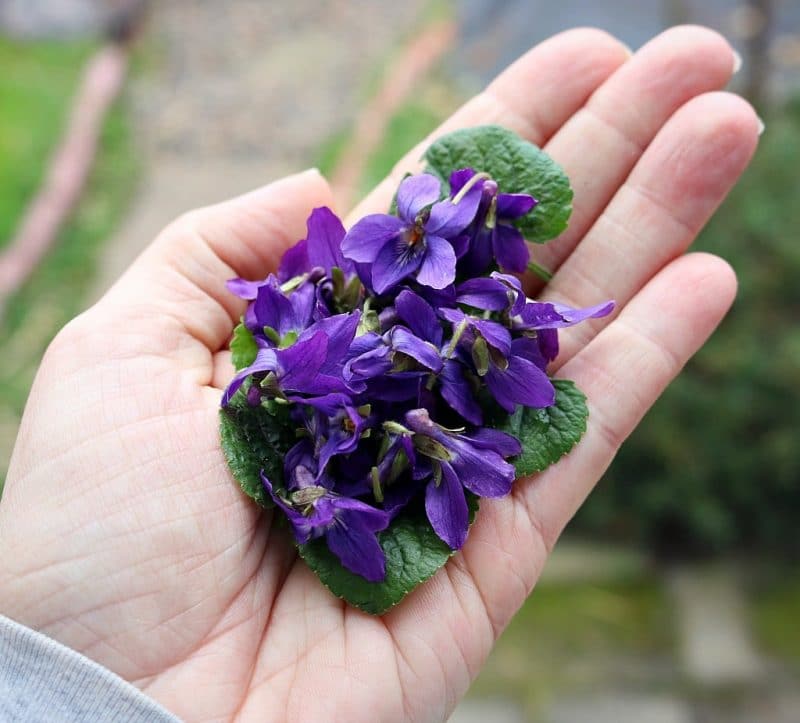
Clover
Both red clover (Trifolium pratense) and white clover (Trifolium repens) are beneficial to us in many ways.
The blossoms are sweet and edible, perfect for adding to baked goods or infusing into honey. Red clover is especially high in vitamins and minerals and makes a wonderful tea.
Make these red clover biscuits or these strawberry white clover cookies!
White clover iced tea is another favorite.
Learn more about red clover and white clover and their benefits here.
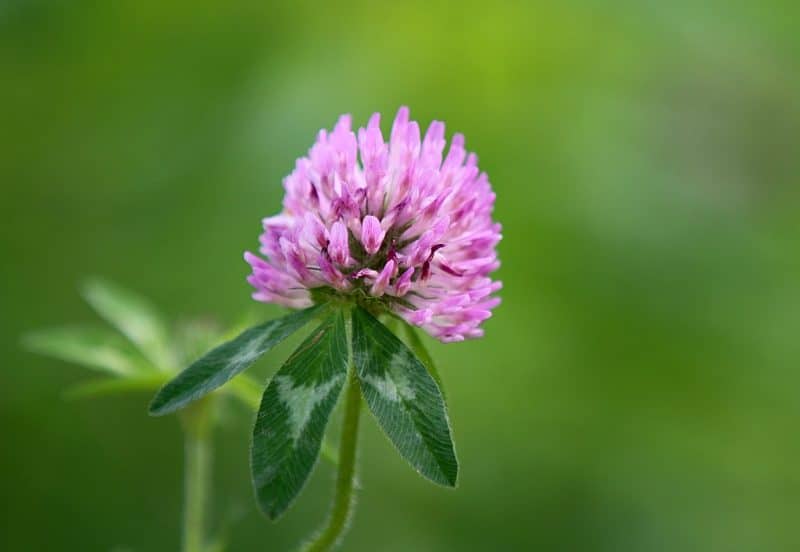
Fiddlehead Ferns
Fiddleheads are fern leaves before they’ve unraveled, and they are usually only available for a few weeks in the springtime.
The fiddleheads of the Ostrich fern (Matteuccia struthiopteris) are the most popular for foraging, as they are the tastiest. They have a flavor that is similar to asparagus and are excellent sauteed with butter and garlic.
Some other varieties of ferns are also edible as fiddleheads, such as western sword fern, bracken fern, and lady fern. These should all be cooked before consuming.
Some varieties of ferns are toxic, so be sure that you consult a guidebook and have a positive identification before harvesting.
Read more about foraging and identifying fiddlehead ferns here.
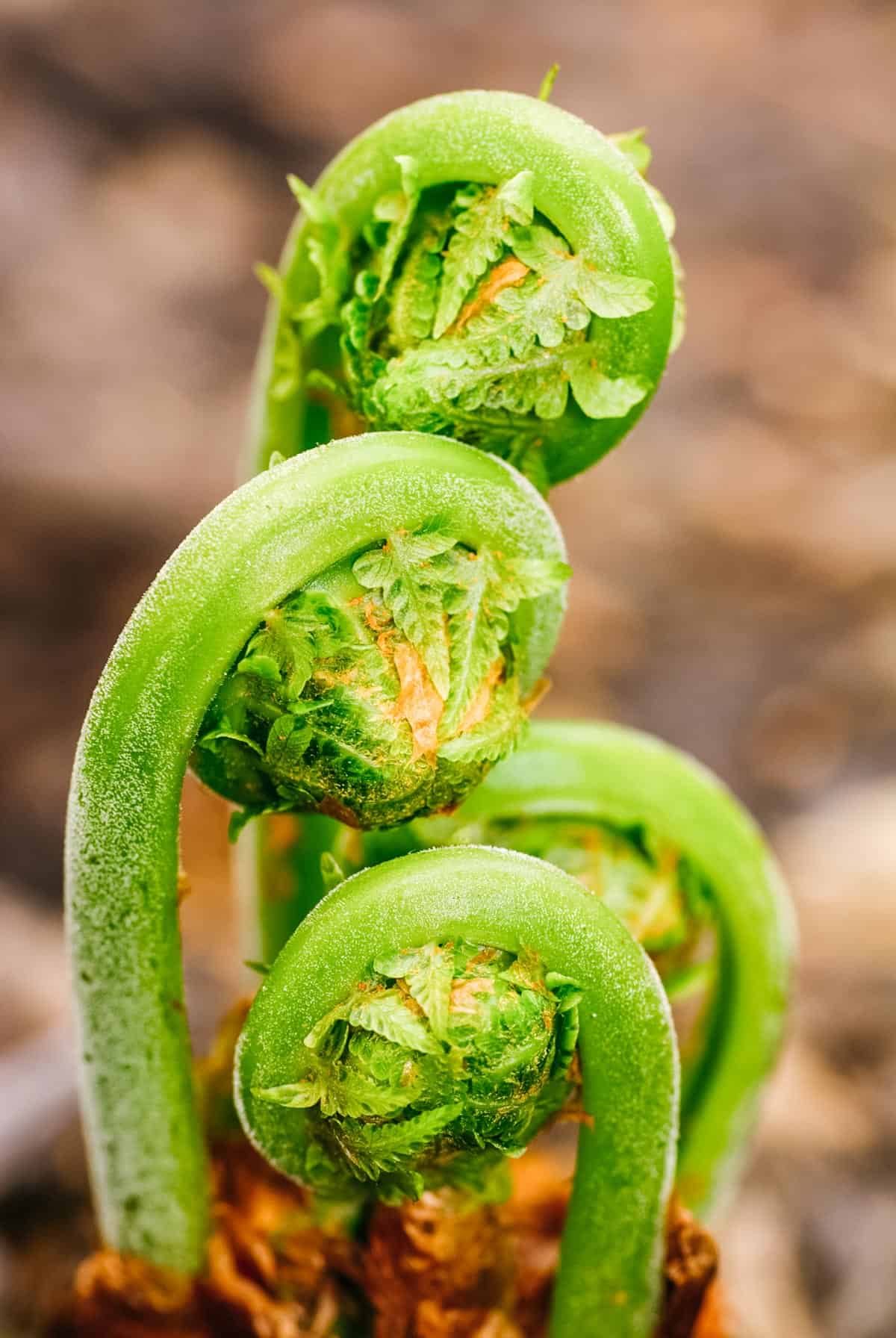
Ramps
Ramps (Allium tricoccum) are also called wild leeks and are in the same family as onions and garlic (Allium). They have a strong onion flavor and can be used just like you would use onions or garlic. I love making ramp pesto. They grow wild in the eastern United States and Canada.
Please note: Ramps require special harvesting practices as they are becoming threatened in many areas. Ramps should be cut leaving the bulb in the ground to regrow.
Read more about foraging and sustainably harvesting ramps here.
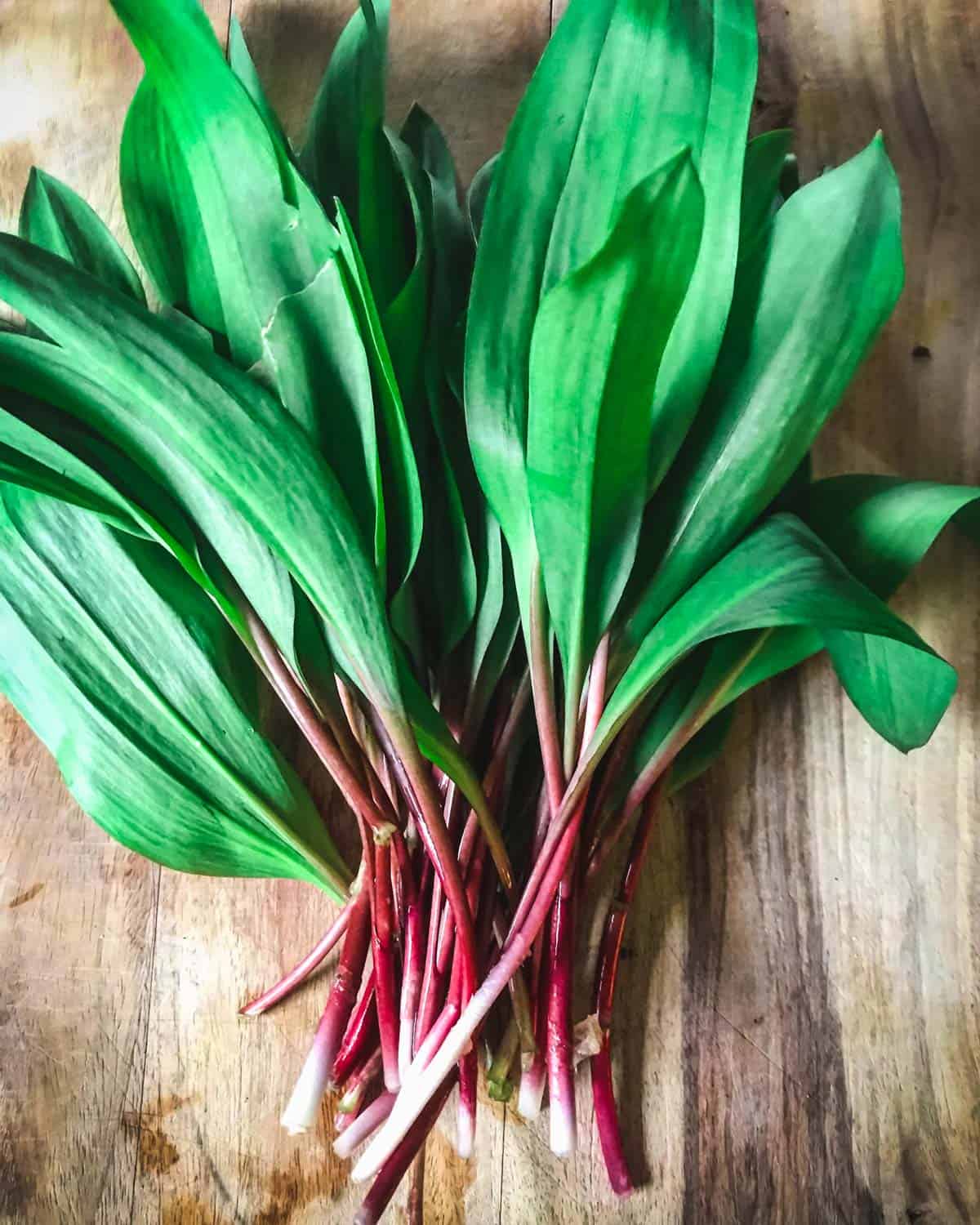
Cattail Shoots (and Pollen)
Cattails (Typha spp.) are known as the ultimate survival plant, as every part of the plant can be used in some way. The young shoots that come up in the spring are the tastiest part, resembling the flavor of a cucumber, and can be eaten raw.
The yellow pollen that covers the flower spike in late spring or early summer makes a delicious foraged flour substitute.
Make fermented cattail shoots or cattail pollen pasta!
Read more about foraging for cattails and cattail pollen here.
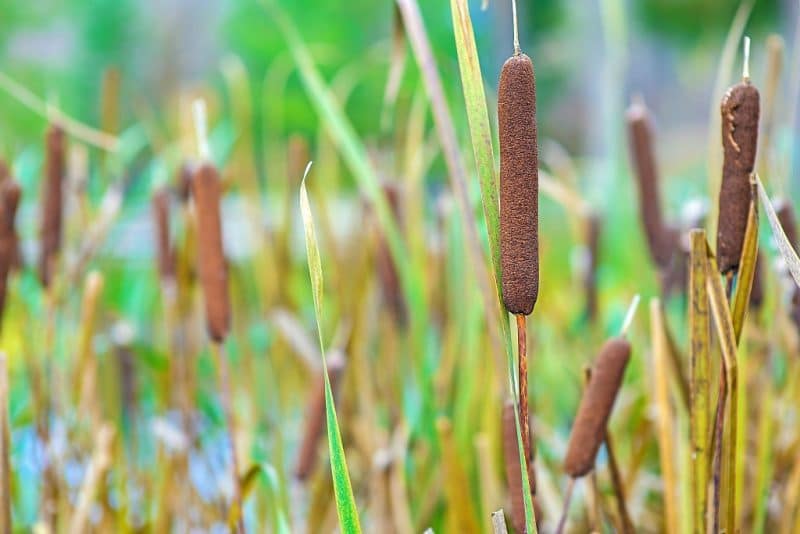
Wild Asparagus
Wild asparagus (Asparagus officinalis) is one that I’ve never found myself, but would absolutely love to one day! They are found in patchy areas throughout the United States and Canada and are notoriously difficult to spot.
Wild asparagus is just like regular garden asparagus in flavor—which means delicious! You can bet I’d make Fermented Asparagus & Garlic with it if I did find it!
Read more about foraging for wild asparagus here.
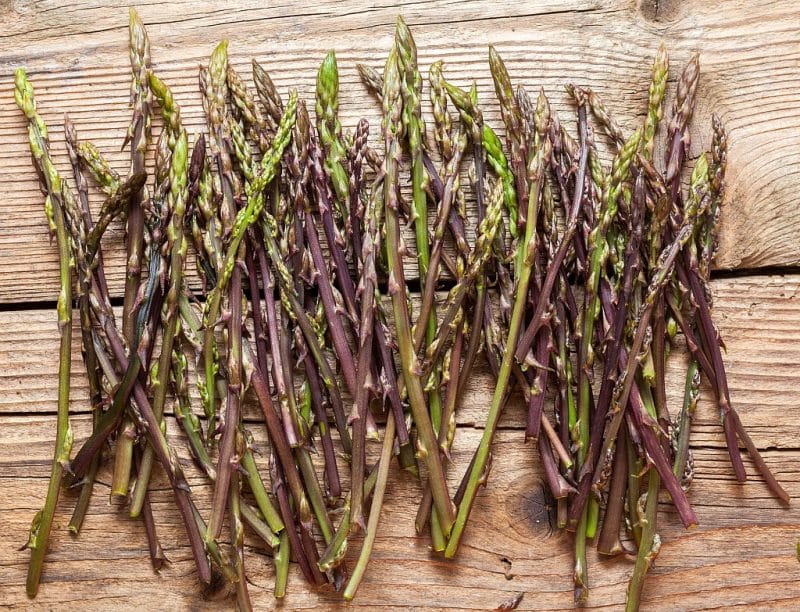
Stinging Nettle
Stinging nettle (Urtica dioica) is one of my favorite plants to forage for in the springtime. They are usually pretty easy to find, but don’t forget to bring a pair of gloves for harvesting!
Nettle is a superfood that is packed full of vitamins and minerals. Cooking the plant will dispel its sting.
Make this stinging nettle-ade recipe or these nettle chips with your foraged nettles!
Learn more about foraging for stinging nettle here.
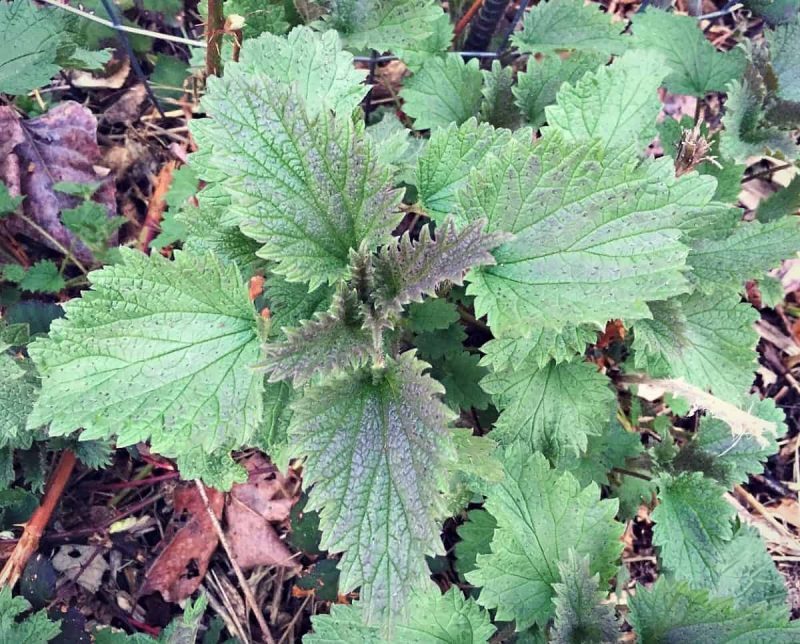
Dead Nettle
Dead nettle got its name because of its supposed resemblance to stinging nettle (I don’t see it) but without the sting.
Purple dead nettle (Lamium purpureum), which is pictured below, is the most common variety and is often found in backyards or gardens. It is perfect to add to a wild greens salad or pesto.
Learn more about foraging for purple dead nettle here.
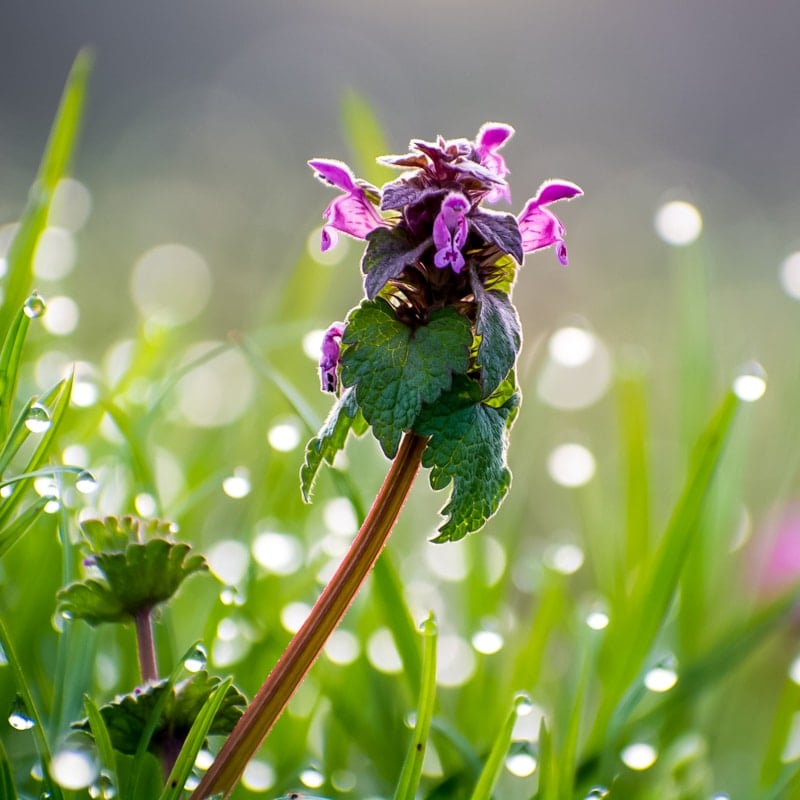
Purple dead nettle is one of the plants covered in my gather + root online foraging course! Sign up below to get free info sheets from the course, all about purple dead nettle.
Henbit
Henbit (Lamium amplexicaule) is in the same family as purple dead nettle, and they are often confused with one another. If you compare the two photos above you can really see the difference between them.
This is another tasty green that can be added to salads or made into a wild pesto. Chickens love henbit too, which is where it got its name!
Learn more about foraging for henbit here.
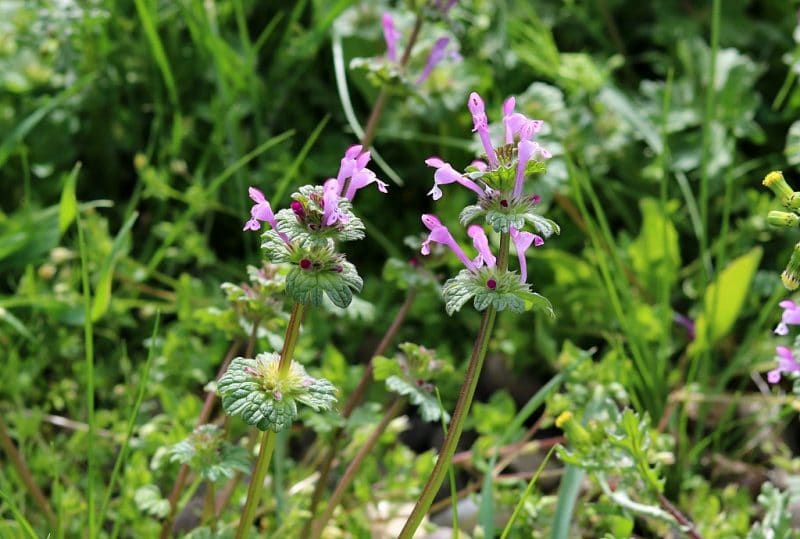
Garlic Mustard
Garlic mustard (Alliaria petiolata) is a prolific plant that is sometimes considered to be invasive. This means that you can and should harvest as much as you want! It has a strong garlicky flavor that is tamed by blanching.
Make this garlic mustard pesto with your foraged greens!
Learn more about foraging for garlic mustard here.
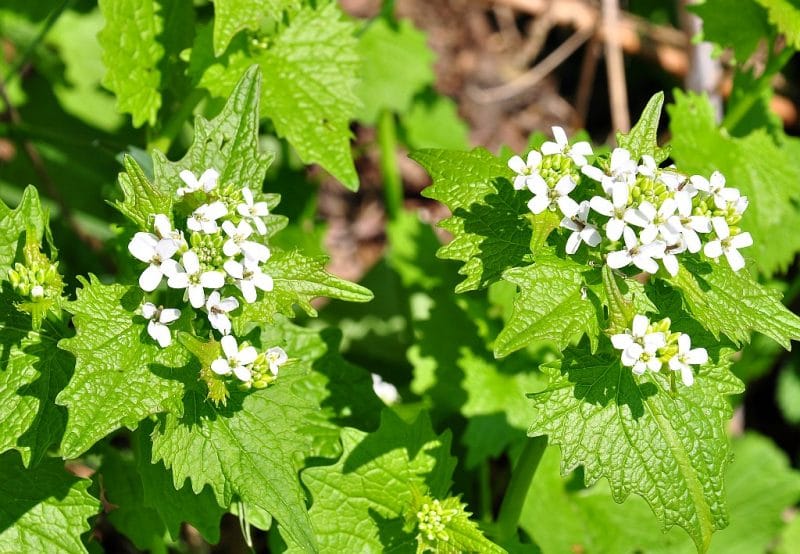
Willow
Most everyone is familiar with soft and fuzzy pussywillows that emerge in the springtime. Not everyone knows that willow (Salix spp.) is a highly medicinal tree! White willow bark in particular is a powerful pain reliever—it actually has the same compounds in it as aspirin!
Make willow bark tea to help ease your aches and pains.
Learn more about foraging for willow here.
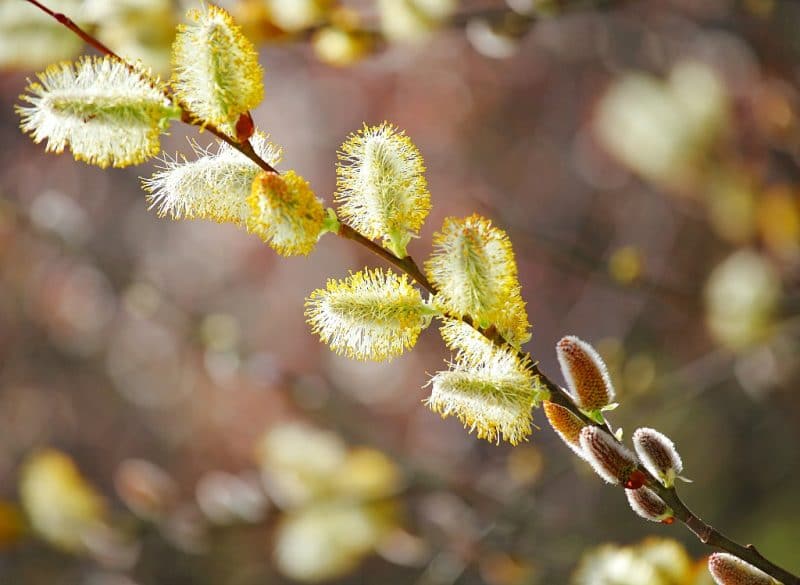
Yarrow
Yarrow (Achillea millefolium) is another highly medicinal plant that comes up in the spring. Its frilly, frond-like leaves make it easy to identify. It is also technically edible, but is quite bitter so is most often used for medicinal purposes.
Use yarrow for treating fevers and coughs, or to help stop bleeding. I also have this recipe for wild rose and yarrow soap and yarrow salve!
Be aware that yarrow can sometimes be misidentified for poison hemlock!
Read more about foraging for yarrow here.
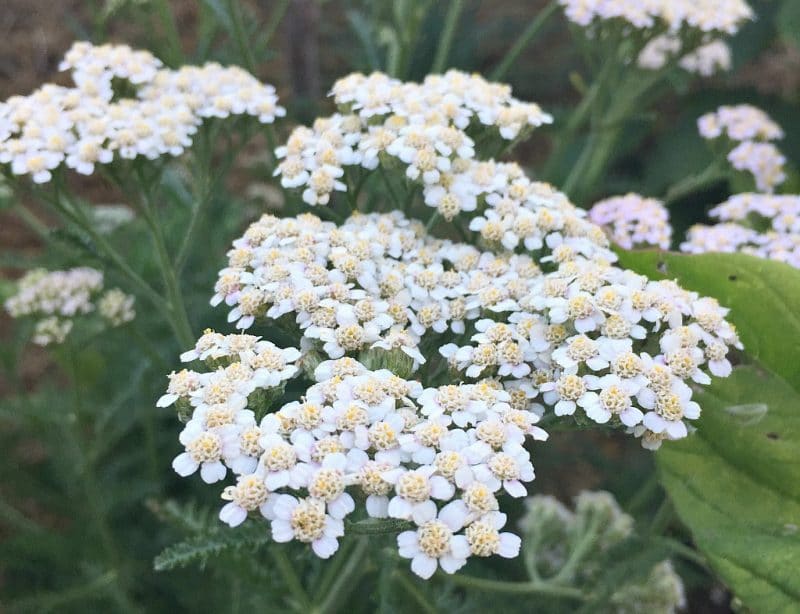
Plantain
Plantain is both edible and medicinal and is a very important herb to know about. There are two main varieties, broadleaf plantain (Plantago major) and narrowleaf plantain (Plantago lanceolata), and both are beneficial.
Young and tender plantain leaves can be eaten raw and are highly nutritious. Older leaves can be added to soups and stews.
Using plantain medicinally is as simple as chewing up a leaf and putting it on a bug bite, bee sting, or minor wound. It stops itchiness and helps to heal wounds. Plantain is also a great herb to use in an herbal salve.
Read more about foraging for plantain here.
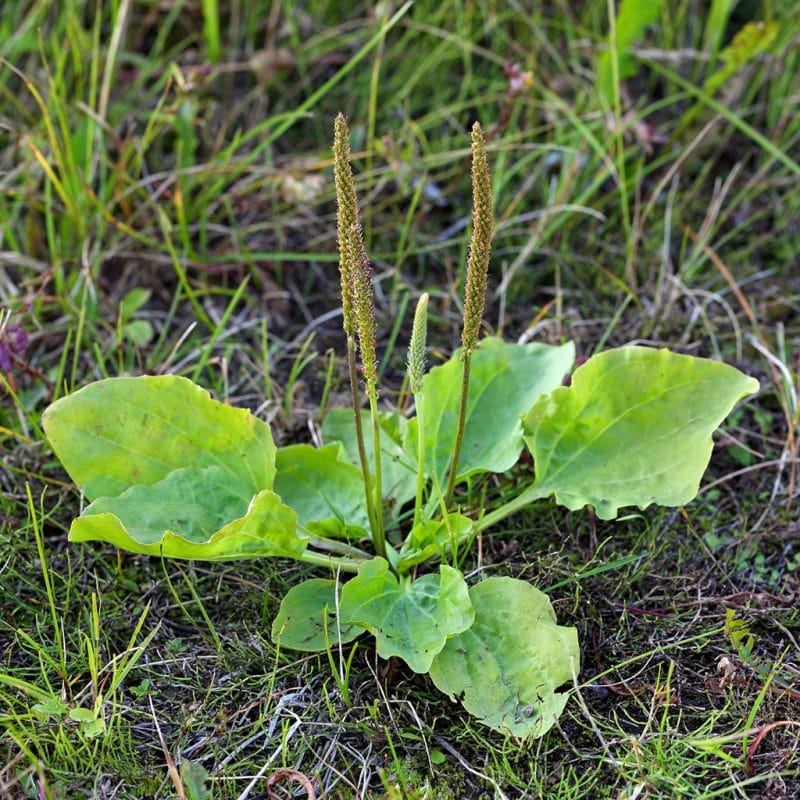
Cleavers
Cleavers (Galium aparine) is a plant that often surprises people with its medicinal properties! It is most well known for its habit of being a pesky garden weed and sticking to everything.
Turns out that cleavers is highly nutritious and is good for the lymphatic system. It is edible, but I recommend blanching first to dispel the sticky hairs.
Here are some great recipe ideas for using cleavers.
Read more about foraging for cleavers here.
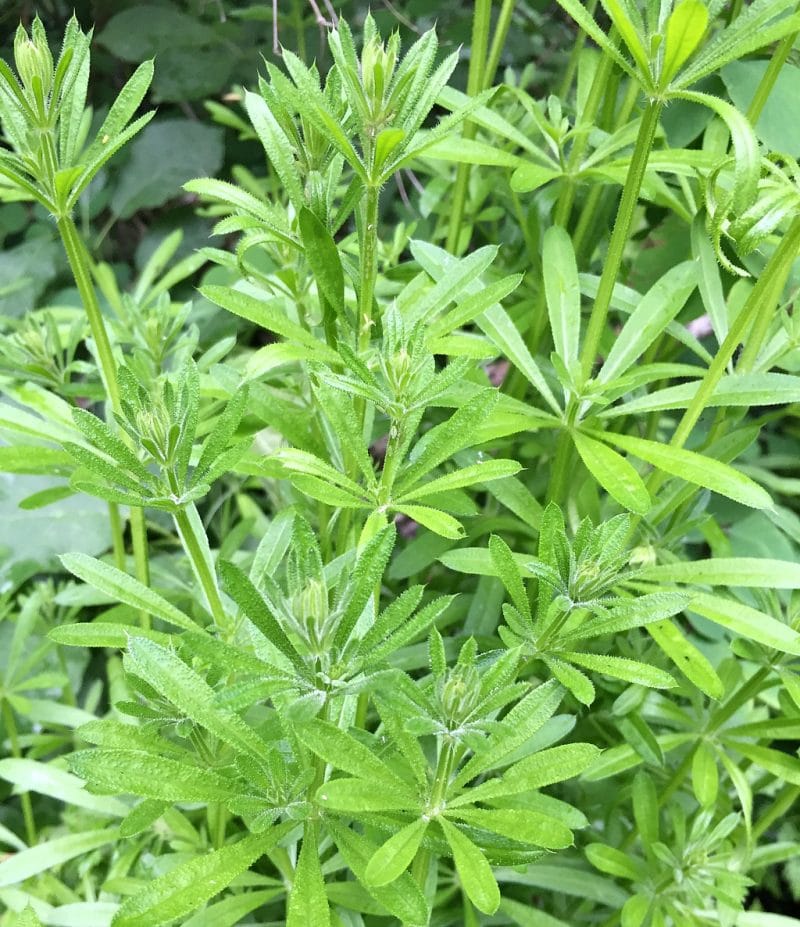
Morel Mushrooms
Everyone gets excited about the thought of finding morel mushrooms (Morchella spp.) during spring foraging forays. Maybe it’s because they have a relatively short season, or that they can be a bit elusive to find. Regardless, morels are some of the best mushrooms to forage for in the springtime!
Be sure to use a mushroom guidebook whenever you are out mushroom hunting.
Morels should be cooked before eating and can be used like any other mushroom in recipes. Try them simply sauteed or even deep fried!
Learn more about foraging for morel mushrooms here.
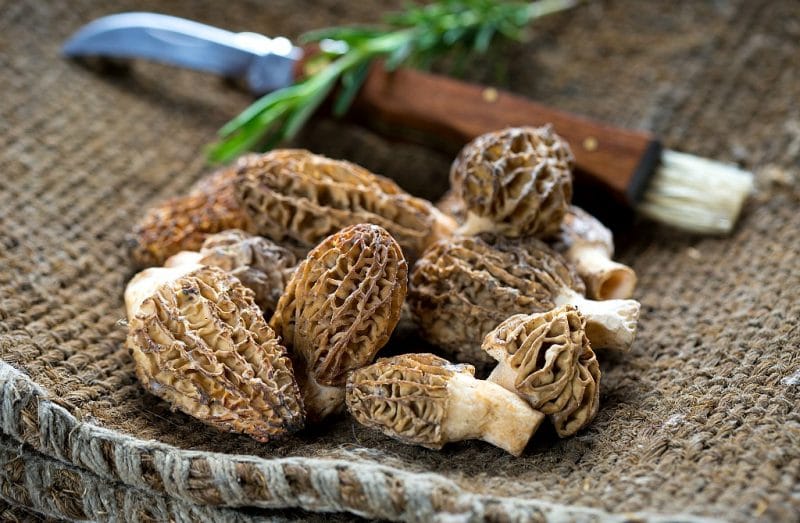
Oyster Mushrooms
Oyster mushrooms (Pleurotus ostreatus) will grow spring through fall in many locations.
They are relatively easy to identify because they always grow on trees or stumps (if it’s not growing from a tree, fallen log, or stump, it’s not an oyster mushroom!). They are also some of the tastiest wild mushrooms around.
Be sure to use a mushroom guidebook whenever you are out mushroom hunting.
Learn more about foraging for oyster mushrooms here.
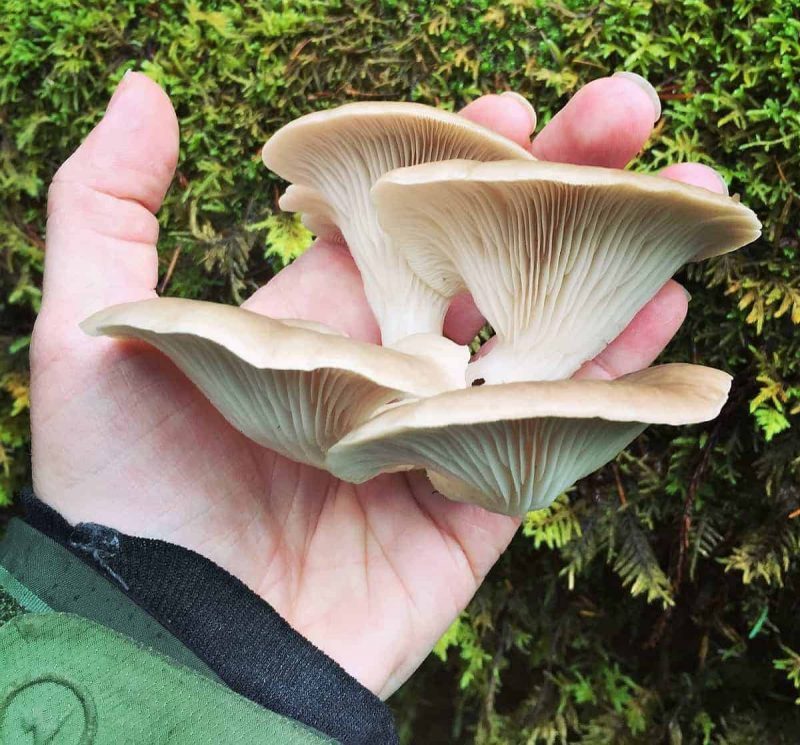
King Bolete Mushrooms (Porcini)
King boletes (Boletus edulis), also known as porcini mushrooms, are considered a delicacy in many places for good reason: they’re delicious!
“Spring Kings” are often found growing in the forest duff underneath conifer trees, and they start to emerge in the springtime. King boletes will also commonly grow in the late summer and fall after rainfall.
Boletes can sometimes be tricky to identify, be sure to use a mushroom guidebook whenever you are out mushroom hunting.
Learn more about foraging for king bolete (porcini) mushrooms here.
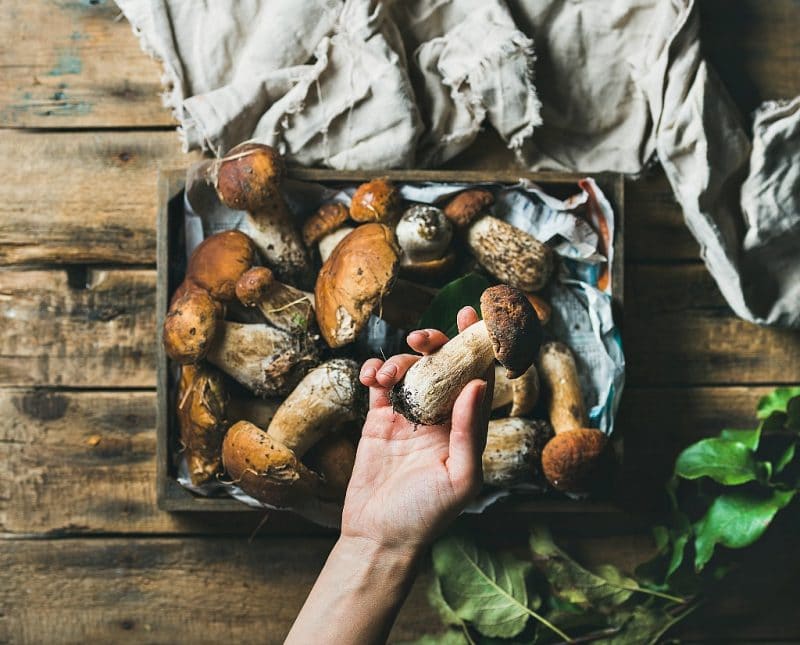
I hope this list has helped you learn what to forage in spring. It really is a great time of year to get outside and collect some wild plants and mushrooms. Happy spring foraging!

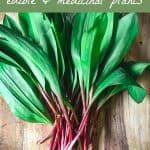
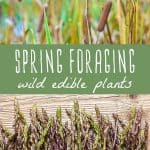
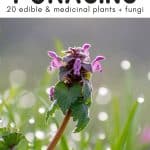
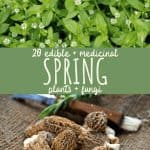
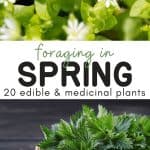
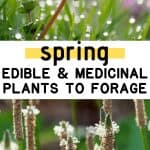
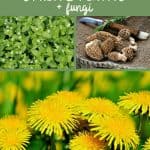
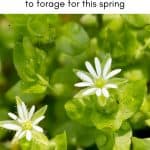
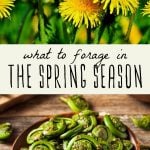
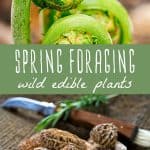

Hey there, It’s so sad to see when people encourage others to take ramps, especially when showing a photo of the whole plant and bulb — honestly, it’s irresponsible. People are denuding whole areas of ramps. Even it if’s plentiful where you are, it’s not in many places. I wish you’d delete that section, and definitely that photo!
I appreciate your concern about ramps, but I state very plainly in the section about ramps: “Ramps require special harvesting practices as they are becoming threatened in many areas.” And I link to a source that goes over how to sustainably harvest ramps. As I’ve said before several times in the comments, I don’t live in a region where ramps grow, so I don’t have access to a photo of sustainably harvested ramps. I’m working on getting one, and will update the post when I do.
The ramps photo has been changed to show sustainable harvesting.
Do you have any blogs on foraging in other seasons?
garlic mustard is delicious but it is a class A invasive in MOST states. including oregon and washington. when we volunteer to do a garlic mustard pull, a 20 acres plot can yield a ton of growth! because it germinates so early in the spring and begins with a whorl of leaves at the base, it crowds out native plants that would feed our native fauna species, from insects to birds. when we come in from weeding, we have to hose off our boots, because it goes to seed early, too. we often tease that we are going to hold a garlic mustard cook-off, but i guess we’d (pun there, sorry) have to hold it in the very quadrant to which we were assigned – no taking it home! if you find some, don’t let it go to seed – pull it before it blooms, roots and all. the leaves are tastier and better texture before it blooms, anyway. believe me, there will be more there next year!
Great post but also unhappy about you showing the ramps/wild garlic roots. It’s so important to just harvest the leaves and leave the bulb. I’ve got a photo you could use instead?
Just skimmed comments to see if this has been said before posting it myself.
Linking to responsible harvesting practices is fine, but please demonstrate what it looks like in your imaging too <3
The ramps photo has been changed to show sustainable harvesting.
When we harvest the ramps, we eat the bulb, we replant the roots in a corner of our yard. They will come up again the next year. Nothing goes to waste! We have a nice patch growing now.
It’s surprising to hear ramps are threatened in some areas. We have millions of them on our wooded property. When we walk in the woods the smell is overwhelming. Actually we have several wild plants/flowers that grow like weeds (pun intended) that are endangered elsewhere. We are certainly blessed!
Great article. I loved the pictures – they are clear and one can see the differences between the plant varieties. I’d like each one to be pictured from a bit of a distance so we can see the size of them. Very appreciative of your clarity. Thank you!
Great article! I’m happy to share! We should all take notice of the food sources around us.
Be VERY cautious about recommending medicinals. Willow is indeed like aspirin, and a person who is on blood-thinners and uses willow bark or extract is in danger of bleeding to death even from a small cut. I’ve speak from experience, I prescribed the willow without being aware of the blood-thinner he was taking. Luckily he got to the ER on time. Yes, I almost killed my father-in-law. I hope God forgives me because I sure won’t. And nowadays with all the drugs people take, you just really need to get educated for real if you’re going to use them. I mean medical school and pharmacy school, the real deal. Nobody wants to carry this burden. What if he’d died!!!
Medical nor pharmaceutical school will be of much help here but any herbalist worth a grain of salt should know that white willow contains the same active constituent as aspirin.
Wow! Just read through this amazing article, can not believe that everything here I thought were just weeds!! I cant wait to tell my boyfriend and friends how we can Use them in so many ways.
Thank you!!!
Colleen, This is a good article I shared to our Bangor forest garden page. Ramps are becoming threatened in many areas so why are you encouraging people to pull them out whole?. Its the first we’ve seen. No one pulls them up in the UK. We harvest the leaves and the flowers. Here, by publishing such a good article that many will share with photos of them pulled up you are encouraging people topull them up!
Can you republish this article with photos of just the leaves please? otherwise we will delete it at our site, thanks.
Hi Frank, I appreciate your concern. I’m not at all encouraging people to pull up ramps with their roots. In fact, if you read the section on ramps, I specifically say that they are becoming threatened in many areas and require special harvesting practices, and I link to an article that discusses how to sustainably harvest ramps. If you read further down in the comments section, you will see that I’ve already addressed this. Ramps do not grow in my region (western United States) so I unfortunately do not have the ability to take the proper photos. The photo I used in the article is the only one I have available to me at this time. I am working with foragers in areas where ramps grow to try and get some updated photos that show them being harvested sustainably.
It was way back in 1993 but a friend showed me a spot that was around 3 acres full of leeks. It was on an island in a river and flat ground, they usually grow on the south facing hill and are the first green thing in the woods around here. I am in the Ottawa Valley but the patch I am talking about is North eastern lake superrior.
We harvested 2 5 gallon pails in half an hour because they were so plentifull, we were carefull though and have always only taken small amounts from one spot. They are totally amazing.
Good article. I jyst wanted to mention that cleavers can be used as a protein coagulant for use in cheese making in place of rennet or caragheenan. Put it into a cheesecloth sachet first, of course!
Remember to cut mushroom and not pull them out. They have a delicate root system, which needs to remain to continue to produce. I live in central California, we find Chantrelle mushroom here. Very delicious.
Hi karren, I’m also in central California, Porterville. Where do you find wild mushrooms and what kind?
Brian please tell me more about cheese making. I am trying to be more self reliant to feed my large family. will have goats milk shortly as they are due to kid this week. thanks
I am a single lady. I started mushroom logs this Spring in Alabama. We drilled holes in oak logs for shitake mushrooms. We used some poplar trees for oyster mushrooms. We have about 80 in the shade. I will be glad to share pictures for anyone who wants to know how they produce for us.
I’d LOVE to know how your mushrooms fared!
I would love to know more. My “Gathering Group” is just starting to look at foraging. I live in the “near North” in Ontario, Canada.
hi I want to start growing mushroom and am very interested in yours
I’d love to see photos of your mushroom logs. I have Chanterelles. I’m in Mobile.
Would love to see and know how they do
How successful was your mushroom operation?
I love harvesting lambsquarter aka pigweed (incorrectly) as soon as it appears. Mix it with baby purple dead nettle for a lovely salad. Or cook with little garlic and lemon. Or use a green layer in lasagna.
Lambs quarter is related to the Quinoa family and Pig weed is an amaranth. The two are not the same.
That is why it’s better to use scientific names! Common names vary from place to place.
In New Zealand some people boil plantain leaf and put it on stubborn boils to help draw it out. My family has used it many times and it always works really well.
Thank you for this list! I am new to using herbs/foraging so this spring and come summer i am looking most forward to it!! I also have your book which is one of my favorites (next to Jan Berry’s 101 Easy Homemade Products). I just cant get over the negative comments! I am pretty sure Colleen knows what she is talking about and i trust her posts :)
Bracken fern are considered carcinogenic now. Please edit to take that fern out of the list.
They are indeed edible, but some care needs to be taken with how they are prepared. Please see this post from experienced forager Hank Shaw to learn more.
Wish I had these here in the desert… ask around, if I seeded these could I grow here? If so which ones and where would i get seeds? TY
Most of these like damp, forest. I wonder if the plantain would grow in the desert. There are many desert plants that can be foraged also. There are books on the matter and videos on youtube also.
Plantain grows in my groveled driveway. I live close to the beach which is not a forested area.
I think it would be good to list a warning for any plants that have a look alike that are poisonous.
Some plants are alsmot identical but can be deadly. For example the wild onion and there is one that doesn’t smell like an onion but looked identical but is highly poisonous.
Hi Deanna, I understand your concern, but this is just meant to be an overview of which plants are available to forage in spring. For each plant I have linked to a more in depth article that will explain all of those details.
Thanks for the interesting article. Funny, I’ve never known about cleavers, but as soon as you described their clingy ways and I saw the picture, I recognized them. Will give these a try!
They are known as Sticky Willy in the UK!
They can unclog your lymphatic system, when I researched I found there was one herbalist who wrote a book many years ago claimed she had known someone clear throat cancer using them. They also help you loose weight. I had a problem once and needed to detox quickly so I used them to make tea. I blended them with water and then strained the green liquid which I kept in the fridge. For the tea I added about 30 ml to boiling water with cinnamon and ginger, I started to really enjoy this drink and carried on with it for a few weeks – I must do this again..
I clicked on the link to learn more about King Bolete harvesting, because as far as I know, they don’t show up until late summer. The article confirmed this, so now I am wondering why they are listed here as a spring edible to forage. Do they appear in the spring in some areas, just not Washington State where I live?
I will look into it more, but as far as I know they appear from late spring through fall, depending on location.
Kings grow in both spring and fall. They are slightly different, and one is more choice than the other (fall I believe,) but they are considered a spring edible.
Posting the scientific name of these plants would be useful. Sometimes the common names apply to more than one plant.
This is so true, botanical names should always be used first and foremost.
I do not know how to start a thread but I need to advise about wild asparagus hunting. We had a lot of it growing around our part of Southern KY. It tends to grow in fencerows and ditches between a field and the road . You won’t be able to see it until it is too tall to harvest but sometimes if you check those spots there will be new shoots coming up under the thatch. If you cut it be sure to cut at the soil line to encourage it to regrow before the season ends.
If you do not spot a patch until it begins to go to seed (they get quite tall), make a note of the location of the patch. Then start checking it when the season begins. Your State Agricultural Extension Service will probably have info about the growing season.
It was hard for us to get any because the mailman knew where all the best patches were because he drove everywhere, and he kept them cut back..after all he drove by them every single day!!! Rural Route carriers, gotta love ’em! Sometimes he would give a bunch to my dad (co worker and lifelong friends)
It is getting harder to find because the farmers now plow much closer to the road, and the herbicides are not good for them either.
It is very delicious and when I was growing up it was the only source for fresh asparagus unless someone was growing it in their garden Short short season too.
Please be careful because oyster mushrooms resemble angel wings which is a very poisonous toadstool not mushroom
It is actually a bit of a controversy if angel wing mushrooms are toxic or not. Please watch this video from experienced mushroom hunter Adam Haritan of Learn Your Land for more info.
We eat angel wings whenever we find them. They’re delicious.
Can Plantain but ground and put on eczema to stop itching? Is there a reason it has to be chewed? I.e. it needs the amylase in saliva?
Hi Doug. Plaintain can be chopped up and placed on the skin. You can also infuse it in oil and rub it on. Or make a salve with the infused oil to rub on. The one pictured is Plantago major. My yard has the long skinny leaves, called Plantago lanceolata. Both have the same benefits. I hope that helps.
Posting a photograph of ramps with the bulbs and roots attached is a bozo no-no. Ramps are overharvested in many areas, and taking the entire plant is not sustainable. Harvest leaves only. Leave the bulbs.
Ramps don’t grow in my area (I live on the west coast) so unfortunately that was the only photo I had access to when I wrote the post. I am working with a forager on the east coast this year who is going to take some photos of how to sustainably harvest ramps for me and I will update this post with them later this season. I did provide a link to a post in the ramps section above that tells you how to sustainably harvest them. (PS. calling me a bozo isn’t really necessary, now is it?)
No, it was not. >:(
No it was not! I love all the info I get from you. Thank you for all your effort to gives as much info as possible
I have to second the suggestion that ramps should not be on this list. Too many people take a grocery store approach to foraging
The patch near my house was completely wiped out in one season. That image is improperly harvested to compound the issue. May i gently suggest replacing it with the invasive japanese knotweed. Which has both food and medicinal properties.
I’m not going to remove ramps from the list because they are a wonderful and delicious plant to forage for, as long as they are done so in a sustainable way. I have linked to an article that explains that method, and I am in the process of getting new pictures and writing a post about how to sustainably harvest ramps. (They don’t grow on the west coast so it has taken me a bit of time to get the proper photos, as I have already mentioned).
I guess bozo no no is a cute expression, but I hope you don’t use it anymore.
How are Cleaver’s dried out? And do you know if they can be frozen fresh and still retain their medicinal value?
Regarding Yarrow: Please show a photo of Poisonous Hemlock alongside! I thought that I had Queen Anne’s Lace in my backyard but, to my horror, discovered that it was poisonous hemlock! Yarrow flowers may also be confused with hemlock.
Hi Daria, I have a post all about poison hemlock and its look-a-likes (I will also add this link to the yarrow section above).
I have a question. I am severely allergic to aspirin, would I be allergic to.the Willow buds as well since it’s the same plant?
yes ! aviod if you are allergic to asprin
It’s possible. Although Natural Willow is no longer used to make Aspirin, it is made from a synthetically created specific compound of the Willow tree called Salicylic acid. If it’s actually the salicylic acid you are allergic to then you may be allergic to Willow also. It’s possible you are allergic to something else in the formula or just the synthetic version, quite often synthesizing a compound changes the compound in a profound way. It’s up to you and the severity of the allergic to decide if it’s worth trying.
Hawthorn berries bread and cheese, are aspirin substitute. (don’t take if on pharmaceutical beater blockers.. Induces coma, can be fatal.
AcidSalicylicacid = ASA willow inner bark and unopened buds contain the same except without being an acid compound.
I would not use willow if you are allergic to aspirin.
Yes, the active ingredient in both aspirin and willow is salicylic acid (one synthetic, one natural, but chemically identical).
Yarrow can also be used as an emergency bug dope.
Springtime spruce tips are also worthy of a mention for vitamin C, use in teas, and jellies.
______________________________Spruce Tip Jelly_________________
Pick spruce tips right away as they “green-up” (in their bio-luminescent light green.) If the tips are “pokey” to the touch, they are no good. So that is, go out and gather when you see that color change! There may be more if you go to the side of the tree where there is less sun.
Chop up spruce tips to make 8 cups. Add 8 cups of water. Bring to boil and simmer for 10 minutes. Let stand overnight. Strain. The color will be murky pale. You can add blue plant based food coloring to make it green.
To 7 cups spruce tip juice, add 1 cup lemon juice.
(No natural pectin in the tips.) 2 boxes of the pectin. Mix together. Bring to a rolling boil, stirring constantly.
Add 9-10 cups of sugar (honey substitute[?], return to rolling boil for 2 minutes. You can follow all the other directions for apple jelly on the package directions for canning.
Heat the canning lids in hot water.
I personally, pour in the jars while really hot, screw on the canning lids (wipe the top of jar for better seal) turn them upside down for 15 minutes, turn them right side up and wait for the jars to pop and they are sealed. This stuff is really hot and will burn you so I recommend being careful or use one of those jar-lifters. Every one knows to stay out of the kitchen when I am doing this. Not that I don’t want help, the stirring and pouring molten jelly really burns bad. ~ JoAnn Holmes — Kodiak
(JoAnn is a herbalist friend of mine. She has a product line using all-Alaskan, Native-traditionalist ingrdients.)
Maple sap lightly reduced, not enough to form syrup, instead of a 80-90 %reduction, a 50% reduction makes a wonderfully sweet tea, with hundreds of herbal ingredient choices!
That spruce jelly looks quite interesting! I’m imagining it might be good condiment with salmon. I nibble on hemlock fir tips when they first emerge – slightly lemony and refreshing.
Good morning.
Superb article, but … you wrote, “There are two main varieties, broadleaf or narrowleaf,”
Both of those Plantago’s are botanicals introduced to North America.
Here on Turtle Island, which we First Nations call “North America”, our indigenous botanical, which was here before those plantago’s arrived, and which we did and still use, is our black-seeded plantain, now binomially named as Plantago rugelii.
Indigenous black-seeded plantain is readily identifiable, larger than wide-leaf plantago major, and having noticeable reddish colour on the base of leaf stems, whereas Plantago major plant is green right down to ground level.
People sometimes mistakenly think they are the same plant.
~ Manidoonaateshing-ikwe / Phylmarie Fess, woman of Ojibwe Turtle Clan
And let’s not forget that plantain seeds are also in the same family as psyllium, and can be used in the same ways…
A great blog post, Colleen. I see lots of backyard and field plants that live here on our farm. So interesting to me. Keep up the good work.
Colleen, We have a plant, that grows in our yArd, I heard it was edible…..it’s called Purslane.Purslane provides six times more vitamin E than spinach and seven times more beta carotene than carrots. It’s also rich in vitamin C, magnesium, riboflavin, potassium and phosphorus.I was wondering why that wasn’t one of the plants you listed above. Also, do you have any recipes for it? Another questio I had was…..I was thinking of trying to grow my own mushrooms. I know there are logs you can buy to do this. How would you recommend me starting this? Should I get a log, start them and then plant them in the ground? Would love to hear back from you. Thanks, in advance.
Kat
Purslane is delicious! In Mexico it’s called Verdolagos and we eat it just like a salad greens. I’m in Washington state, and I often find it sprouting up through sidewalks and hanging off the edges of people’s yards.
Kat- I’ve tried buying the mushroom logs. It’s a very expensive way to cultivate your mushroom!. Try to find an article on growing mushrooms in coffee grounds (often in old tights) as that’s a much more cost effective and environmentally friendly method.
The mushroom logs produce a bountiful supply. They need deep shade, moisture and regular harvesting. A friend of mine grew them for several years in KY. She was Commonwealth Secretary of Algriculture at the time and was looking for simple ways for rural women to make money with very little startup and low maintenance. She had a grove of trees and water source and I helped her wet the logs and harvest many times. Her crop was shitaki and she sold them to restaurants all over her part of the state. KY is very humid and the temperature drops at night more than in other places.
I was just going to say that about purslane! You shouldn’t use it if you have an issue with oxalates.
Hi Kat,
Purslane is more of a summer plant, that’s why I don’t have it listed here. It is an incredible edible, though! I’ve grown mushrooms on logs once and I think we’re going to try it again this year. I will do a post on it if it is successful.
I live in East TN . we travel up the mountains including N.C. Really enjoy wild crafting. Also the punk on cat tail can be picked in June when still green or starting to turn brown.Leave a foot of stem. Let dry out on shed roofs. They burn slow. Get rid of mosquitoes. Old Delaware Lenapee Indian Trick. The seeds on plantain stems are high in Omega’s. Thank you.
Kat Datko, thank you for discussing Native botanical
English Language common name – Purslane,
Scientific Language Binomial name – Portulaca oleracea,
Native Ojibwe Language name – gookooshibag
Archaeological Science has found ancient remnants prove Portulaca oleracea is Native to North America.
~ Phylmarie Fess